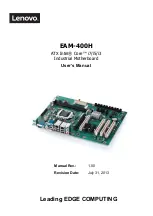Distributor of NXP Semiconductors: Excellent Integrated System Limited
Datasheet of MCIMX53SMD - TABLET SABRE PLATFORM MCIMX53
Contact us: sales@integrated-circuit.com Website: www.integrated-circuit.com
72
MCIMX53SMD Board Hardware User’s Guide, Rev. 0
Freescale Semiconductor
go 70800000
This will begin the OBDS diagnostic tool. The tool has 15 tests that it can perform. They are as follows:
1.
MAC Address confirmation
2.
Debug UART Test
3.
DDR3 Test
4.
USBH1 Enumeration Test (Upper Host Port)
5.
Secure Real Time Clock Test
6.
Dialog PMIC ID Test
7.
SATA Test
8.
I2C Device Test
9.
GPIO Test
10.
Ethernet Test
11.
I2S Audio Test
12.
LVDS Display Test
13.
VGA Video Test
14.
HDMI Daughter Card Test
15.
MMC/SD Card Test
The tests are straight forward, and if a supporting piece of equipment is required, the test will prompt you for
it. In order to complete all the tests, you would need to have the following equipments:
SATA Test: Attached SATA device required.
Ethernet Test: The Ethernet loopback test plug as described below is required.
Headphone Test: A set of earphones or speakers are required.
LVDS Test: The optional LVDS display kit is required.
VGA Video Test: Connection to a VGA monitor is required.
HDMI Test: The optional HDMI card is required.
MMC/SD Card Test: A full-size SD card is required in card slot J5.
If the developer does not have one or more of the above items, the test can easily be skipped when asked if
the user would like to perform the test. A complete cycle of tests covers 16 different aspects of the board.
When the last test is run, the OBDS tool will print out a summary of the test results. A failure in any one
particular area would indicate that there is a hardware fault with the MCIMX53SMD board that should be
addressed. If the developer code does not function correctly even after successfully performing all the tests,
the problem is most likely with the code. A more detailed description of the tests is as follows:
1)
MAC Address confirmation:
The i.MX53 processor reads the MAC address programmed into the
processor eFUSEs and prints it out on the terminal window. The outputted address should match the
MAC address label on the MCIMX53SMD board. If they match, the test was successful.
2)
UART Test:
When the test is running, the test expects different characters to be inputted from the
keyboard of the host computer. When a character is inputted, the i.MX53 processor takes the
character and transmits it to the terminal window, and then asks the user to verify if the character is
correct by pressing the ‘y’ key. The user can exit the test by pressing the ‘x’ key.
3)
DDR Test:
The test writes predetermined data onto the DDR3 memory, reads those memory blocks
back out, and then compares the two values for errors. If the values match, the test was successful.
73 / 82
73 / 82


















